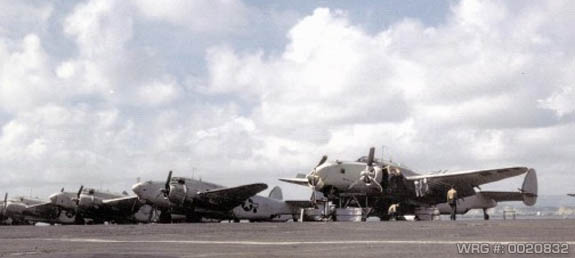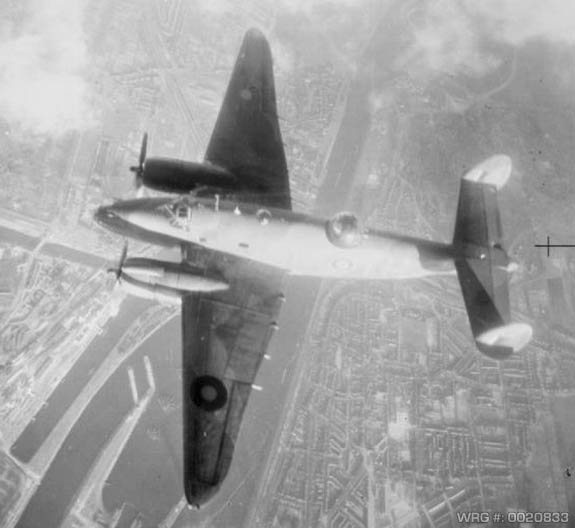|
|
|
U.S. NAVAL AVIATION RESOURCE CENTER > RECON/OBSERVATION/PATROL > VENTURA > PREVIOUS PAGE
LOCKHEED PV-1 VENTURA
Operational History
United States Navy
During the early months of 1942, the primary responsibility for anti-submarine warfare in the United States was shouldered by the Army Air Force. This irked the Navy, as it considered this region of battle its burden. To carry out such a task, the Navy was pursuing a long-range, land-based patrol and reconnaissance aircraft with a substantial bombload. This goal was always resisted by the Army Air Force, which carefully protected its monopoly on land-based bombing. This forced the navy to use long-range floatplanes for these roles. The Navy was unable to upgrade to more capable aircraft until the Army Air Force needed the Navy plant in Renton, Washington to manufacture its Boeing B-29 Superfortress. In exchange for use of the Renton plant, the Army Air Force would discontinue its objections to Naval land-based bombers, and provide aircraft to the Navy. One of the clauses of this agreement stated that production of the B-34 and B-37 by Lockheed would cease, and instead these
resources would be directed at building a navalized version, the PV-1 Ventura.

U.S. Navy Lockheed PV-1 Ventura patrol bombers on an airfield in the Caribbean in 1944/45.
[Source: U.S. Navy]
The PV-1 began to be delivered in December 1942, and entered service in February 1943. The first squadron in combat was VP-135, deployed in the Aleutian Islands in April 1943. They were operated by three other squadrons in this theatre. From the Aleutians, they flew strikes against Paramushiro, a Japanese island. Often, PV-1s would lead B-24 bomber formations, since they were equipped with radar. In late 1943, PV-1s were deployed to the Solomon Islands and to the newly captured field at Tarawa in the Gilbert Islands.
After the war, the U.S. Navy deemed many PV-1s as obsolete and the aircraft were sent to Naval Air Station Clinton, Oklahoma to be demilitarized and reduced to scrap.
Royal Air Force
The Ventura Mark I was first delivered to the Royal Air Force in September 1941, and flew its first combat mission on 3 November 1942 against a factory in Hengelo, the Netherlands. On 6 December 1942, 47 Venturas engaged in a daylight, low altitude attack against Eindhoven, also in the Netherlands. This was the primary event that demonstrated the Ventura's weakness in such raids: of the 47, nine of the bombers were downed. Following this tragedy, tactics were switched to medium altitude raids. The Ventura fared little better in this strategy. During one attack on a power station in Amsterdam on 3 May 1943, New Zealand's 487 Squadron was told the target was of such importance that the attack was to be continued regardless of opposition. All 10 Venturas to cross the coast were lost to German fighters. Squadron Leader Leonard Trent, (later the last of the Great Escapers), won the Victoria Cross for his leadership in this raid.

A RAF Ventura Mark I (s/n AE742 'YH-M') of No. 21 Squadron.
[Source: Imperial War Museum]
It was never a very popular aircraft among RAF crews, and despite the fact that it was 50 mph (80 km/h) faster and carried more than twice as many bombs as its predecessor, the Hudson, it proved ill-suited to its task as a bomber. By the summer of 1943, the Ventura had been phased out of service in favor of the de Havilland Mosquito. Its last mission was flown by No. 21 Squadron RAF on 9 September 1943. After leaving bombardment service, a number were modified to be used by Coastal Command; they served as the Ventura G.R.I.. A total of 387 PV-1s were used by the RAF as the Ventura G.R.V. They were used in the Mediterranean and by Coastal Command. Some RAF aircraft were modified into Ventura C.V transport aircraft.
Royal Australian Air Force
A total of 55 PV-1s were used by the RAAF in the South West Pacific Area, serving primarily in New Guinea. Initially, air crews and ground staff disliked the Ventura, preferring the North American B-25 Mitchell. But in many cases, the PV-1 had developed a grudging respect from its operators.
Royal Canadian Air Force
A total of 157 Ventura G.R. Mk. Vs were used operationally by the RCAF from 16 June 1942 to 18 April 1947 in the home defence coastal patrol role in both Eastern and Western Air Command. They were flown by 8, 113, 115, 145, and 149 Squadrons. A further 21 Ventura Mk. Is and 108 Ventura Mk. IIs were used in a training role at 1 Central Flying School, Trenton, Ontario, and at RCAF Station Pennfield Ridge, New Brunswick (RAF No. 34 Operational Training Unit) as part of the BCATP. A total of 21 Mk. Is, 108 Mk. IIs, and 157 G.R. Mk. Vs were in service during this period for a total of 286 aircraft.
South African Air Force
The South African Air Force also received some 135 PV-1s, which were used to protect shipping around the Cape of Good Hope, and to bomb Italian shipping in the Mediterranean. They were used by the South African Air Force up to 1960.
Royal New Zealand Air Force
From August 1942, No. 487 Squadron RNZAF, (operating in Europe as part of the Royal Air Force), was equipped with the type, although losses (including on 3 May 1943 the loss of all 11 aircraft attacking Amsterdam), lead to their replacement with the de Havilland Mosquito in June.
The Royal New Zealand Air Force in the Pacific received 139 Venturas and some Harpoons from June 1943 to replace Lockheed Hudsons in the maritime patrol bomber and medium bomber roles. Initially Venturas were unpopular with the RNZAF due to rumoured poor performance on one engine, the fate of Squadron Leader Leonard Trent VC's 487 Squadron (above) as well as the failure of the U.S. to provide New Zealand with promised B-24 Liberators. Despite that the RNZAF Venturas came to be amongst the most widely used of any nation's, seeing substantial action until VJ Day over South West Pacific islands.
The first 19 RB-34s that arrived by sea from the U.S. in June had much equipment either missing or damaged. Six airworthy machines were hurriedly produced by cannibalization and sent into action with No. 3 Squadron RNZAF in Fiji. On 26 June the first PV-1s were flown to Whenuapai and No. 1 Squadron RNZAF was able to convert to 18 of these by 1 August, then replacing the mixed 3 Squadron in action at Henderson Field, Guadacanal in late October.
By this time No. 2 Squadron RNZAF at Ohakea and No. 9 Squadron RNZAF were also using the type. The following year No. 4 Squadron RNZAF and No. 8 Squadron RNZAF also received Venturas. Some squadrons were retained on garrison duty while others followed the allied advance to Emirau and Green Island and to New Britain. RNZAF Venturas were tasked with routine patrols, anti-shipping strikes, minelaying, bombing and strafing missions, air-sea rescue patrols, and photographic reconnaissance missions. In an apparently bizarre case of taking Lockheed's marketing slogan of The Fighter-Bomber too literally, even briefly, Venturas conducted fighter sweeps.
RNZAF machines often clashed with Japanese fighters, notably during an air-sea rescue patrol on Christmas Eve 1943. NZ4509 was attacked by nine Japanese single-engined fighters over St. George's Channel. It shot down three, later confirmed, and claimed two others as probables, although it suffered heavy damage in the action. The pilot, Flying Officer D. Ayson and navigator, Warrant Officer W. Williams, were awarded the DFC. The dorsal turret gunner Flight Sergeant G. Hannah was awarded the DFM.
By late 1944 the Ventura began to be phased out of front line action as the RNZAF backed away from the Patrol Bomber concept, orders for PV-2 Harpoons were canceled after a handful or aircraft had been delivered. At VJ Day only 30 PV-1 aircraft remained on the front-line with No. 3 Squadron at Jacquinot Bay.
Planned re-equipment with de Havilland Mosquitos did not take place until after the cessation of hostilities. The last Ventura unit was No. 2 Squadron, which continued to operate PV-1 and PV-2 aircraft on meteorological duty until 1948. A restored RNZAF RB-34 (NZ4600) is owned by the Museum of Transport and Technology in Auckland.
United States Army Air Forces
Some 264 Ventura Mark IIs ordered by the RAF were seized by the U.S. Army Air Force. Though some were used as anti-submarine patrol bombers under the designation B-34 Lexington, most were used for training with various stateside units. 27 of these were used by the United States Navy for anti-submarine patrols as well; these were designated PV-1 Ventura and PV-2 Harpoon.
Sources:
Wikipedia
U.S. NAVAL AVIATION RESOURCE CENTER > RECON/OBSERVATION/PATROL > VENTURA > PREVIOUS PAGE
|
|
|